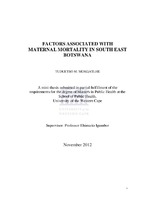| dc.description.abstract | Background: Maternal mortality is a significant public health problem world-wide,as it is an important indicator for the functioning of the health system. The maternal mortality ratio for Botswana is higher than other countries with comparable economic growth, despite impressive access to health services. In order to develop relevant programs and policies to reduce maternal mortality, the factors associated with maternal mortality were studied. The study aimed to describe the maternal and health services factors associated with maternal mortality in South East Botswana. Methodology: A quantitative case-control study was used to retrospectively review medical records for 71 cases of maternal deaths and 284 controls randomly selected from mothers who delivered in the same year and at the same health facility, in South East Botswana from 2007 to 2009. Information was collected on the maternal and health services characteristics of the cases and controls including age, level of education, marital status, parity, utilization of health facilities that consist of antenatal care (ANC), type of delivery, complications during pregnancy, type of health facility and ANC provider. Data was analyzed using Predictive Analysis Software (PASW) Version 18.Two-sample t- test, Pearson’s Chi-square test and the Fisher’s exact test were used to test the difference between the proportions of the various categories of variables in cases and controls. Univariate logistic regression analysis was applied to identify the risk factors associated with maternal deaths. A multivariate logistic regression model was estimated to see the joint effects of the identified risk factors for maternal mortality. Hosmer and Lemeshow test was used to test the goodness of fit of the model. Results: The mean age of the maternal deaths was 28.0 ± 5.3 years and they had taken place at a hospital (100%). A large number of deaths occurred before delivery(59.0%). The causes of maternal death included both direct (73%) and indirect causes (27%). Direct causes were the leading causes of death and they were abortion(22.5%) and haemorrhage (18.3%). The maternal characteristics associated with maternal mortality were having complications at delivery (OR=20.91), not receiving ANC (OR=6.31) and delivering by caesarean section (OR= 2.66). The health facility characteristics associated with maternal mortality were delivering outside the health facility (OR=14.78), having been referred from another facility (OR=8.62) and delivering at a general hospital (OR=5.91). The data produced a model with good fit that included one maternal risk factor and three health facility risk factors. These were being admitted with preterm labour, delivering at a general hospital or before arrival at the health facility and having been referred from another health facility. Conclusion: Maternal mortality was associated with both maternal and health facility risk factors. The model developed may be used to identify and manage highrisk women to reduce the number of maternal deaths. It was recommended that, the current system should continue to be monitored and evaluated through the Maternal Mortality Monitoring System (MMMS). Furthermore, the referral and management of complications needs to be strengthened through a multi-sectoral approach. | en_US |

